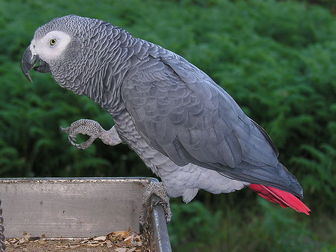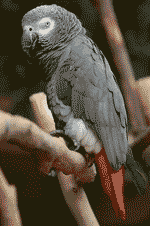Gray Parrot
There are two subspecies universally accepted:

Original source: self made, http://commons.wikimedia.org/wiki/Image:Ave_070910_008.jpg
Author: L.Miguel Bugallo Sánchez (http://commons.wikimedia.org/wiki/User:Lmbuga)It's the same than
Permission: GNU Free Documentation License
 There are not many parrot species living in Africa. This might be due to the aridness of many regions and the lack of fruit-bearing trees. The African grey parrot is one of the few African parrot species. Reaching a length up to 36 cm it is also the largest parrot inhabiting that continent. As the name implies, the African grey parrot is predominantly grey, with accents of white and a red or maroon tail depending on the subspecies. Greys, like all parrots, are zygodactyl, having 4 toes on each foot - two front and two back. They feed primarily on nuts and fruits, supplemented by leafy matter.
There are not many parrot species living in Africa. This might be due to the aridness of many regions and the lack of fruit-bearing trees. The African grey parrot is one of the few African parrot species. Reaching a length up to 36 cm it is also the largest parrot inhabiting that continent. As the name implies, the African grey parrot is predominantly grey, with accents of white and a red or maroon tail depending on the subspecies. Greys, like all parrots, are zygodactyl, having 4 toes on each foot - two front and two back. They feed primarily on nuts and fruits, supplemented by leafy matter.
There are two subspecies of the African grey parrot, which can be found in Central and Western Africa. The birds inhabit forests and feed on fruits, berries, buds, blossoms and seeds. Searching for food African grey parrots wander about - otherwise they are non-migratory birds. African grey parrots often fly at high altitudes, their flight is rapid and straight. They are quite shy in the wild and communicate with shrill whistles and squawks. African grey parrots nest in tree holes. The three or four nestlings stay in the hole for almost three months. Like many other parrot species, African grey parrots can reach a very old age; 60 years and more are not unusual.
The African grey parrot has a great talent to mimic human speech. This made it one of the first parrot species coming to Europe as cage birds. African grey parrots, which are raised by their parents under relativ natural conditions, are quite timid and mostly don't lose this natural timidness towards man for many years. Hand-raised African grey parrots are quite tame from the beginning since they are imprinted on humans. If one decides to keep an African grey parrot, one has to be sure about one's purpose in keeping it and has to know about the life story of the desired bird. If one wants to keep African grey parrots raised by their parents under relativ natural conditions, which is preferable, one should buy several birds, since man can't serve them as an adequate partner. On the other hand hand-raised African grey parrots will enter into a close partnership to their keeper. But this means that the keeper has to be prepared to devote a lot of time towards "his" bird. Otherwise it soon will show "neurotic" behaviours like plucking out feathers. And one has to remind that African grey parrots have a long lifespan and a bird bought at a young age will get old together with its keeper.
This article was originally published at magazine.naturspot.de. Link to the original article
Grey parrot photo by Jason L. Buberal source
| This file is licensed under Creative Commons Attribution ShareAlike 1.0 License: http://creativecommons.org/licenses/by-sa/1.0/ |
The Gray Parrot is classified as Near Threatened (NT), is close to qualifying for or is likely to qualify for a threatened category in the near future.

Family : Psittacidae
Genus : Psittacus
Species : erithacus
Authority : Linnaeus, 1758

